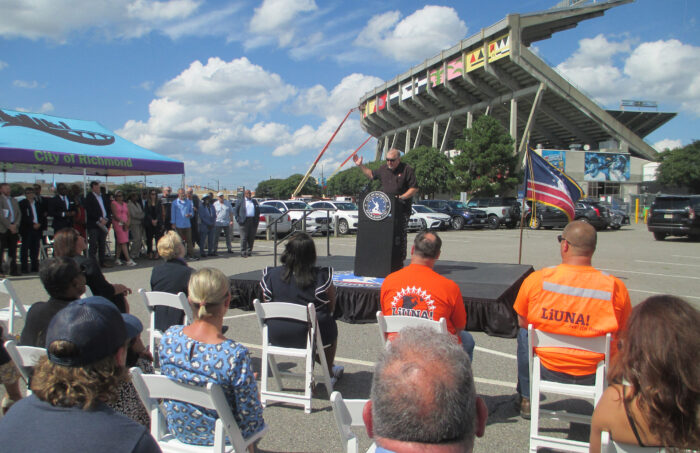
The final agreements come seven months after officials gathered at The Diamond to officially kick off the Diamond District project last fall. (BizSense file photo)
The City of Richmond has reached final terms with developer RVA Diamond Partners for their $2.4 billion Diamond District project – though not in time, officials said, for its centerpiece baseball stadium to be built before a 2025 deadline.
The definitive agreements were introduced at Monday’s City Council meeting, seven months after the parties entered into negotiations after reaching a preliminary agreement last fall. This new phase of the process sets the stage for final approvals that would tee up next steps, including completion of the ballpark’s design, creation of a Diamond District financing authority and the start of construction.
In an interview Monday, officials said the soonest that shovels could get in the ground would likely be early next year, leaving less time than the anticipated 18-month window that would be needed to complete the new stadium in time for the 2025 ball season – the deadline set by Major League Baseball.
While he acknowledged that the stadium would not be built in time to meet that deadline, Lincoln Saunders, the city’s chief administrative officer, said the parties are hopeful that, with the project underway, MLB will work with them to keep the Flying Squirrels ballclub in Richmond.
“It’ll be difficult if not impossible to meet the Opening Day 2025 deadline,” Saunders said, putting the stadium’s completion closer to spring 2026.
“We do believe that, when MLB sees the city’s commitment and the fact that we are looking to build a stadium with a high-quality fan experience, we can work with them on the timing for continuing in the existing Diamond and then transitioning to a beautiful new stadium by spring of ’26.”
Whether MLB would extend its deadline is not known. A request to MLB for comment Monday afternoon was not returned.
MLB, which in recent years took over management of Minor League Baseball, set the 2025 season as the deadline for all pro baseball facilities to meet new facility standards, which the 38-year-old Diamond does not. While upgrading The Diamond to meet those standards has been deemed unfeasible, MLB this year required $3.5 million in improvements ahead of the current season, which got underway this month.
Whether this revised timeline means the city will lose the Flying Squirrels – its minor-league ballclub of over a decade – remains to be seen.
Two weeks ago, in a statement to the Times-Dispatch, Flying Squirrels President Lou DiBella expressed concerns about the Diamond District’s progress and said “there will be no Opening Day 2026 in RVA” without the new stadium.
Acknowledging the situation, Saunders said Monday, “We know time is of the essence, and we want to be able to start building and break ground on a stadium for the Flying Squirrels as quickly as possible.”
DiBella and Todd “Parney” Parnell, the Flying Squirrels’ CEO, could not be reached for comment Monday night.
Saunders said the parties have been in constant communication with the ballclub.
Referring to DiBella’s statement, Saunders said, “I hope that seeing the progress we’ve made and the high level of thought that’s gone into crafting this agreement will address the concerns he rightfully raised about timing, and we need to get building.”
Incremental financing area expanded
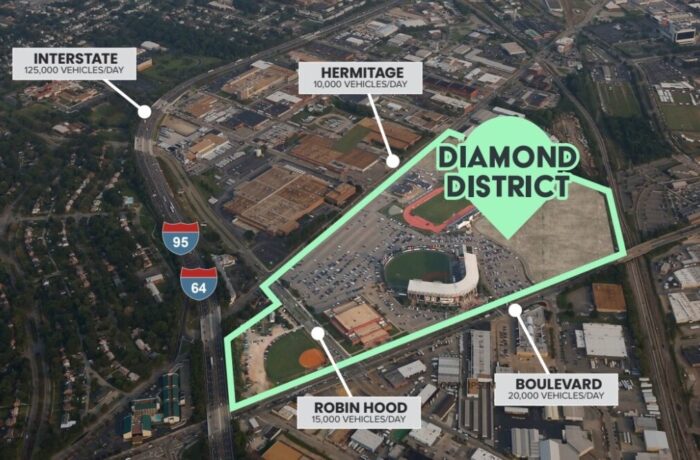
The 67 acres are bordered by Arthur Ashe Boulevard, Hermitage Road, the interstate and the railroad tracks. (City documents)
The final agreements expand on minimum business terms and conditions that were agreed to by the parties and were approved by council last fall.
While the bulk of the overall project hasn’t changed, the new stadium is now projected to cost $90 million with a capacity of 9,000, compared to previous projections of $80 million and 10,000.
Jason Guillot, a principal with Thalhimer Realty Partners and the local lead for RVA Diamond Partners, said the major change that came out of the negotiations – and what primarily contributed to their duration – is in the project’s financing plan, which is now based on a larger tax increment financing area.
That area – tax revenue from which would be used to help finance the development over time – now includes adjoining properties beyond the 67 acres that make up the Diamond District site, including properties directly across Arthur Ashe Boulevard, Hermitage Road and Robin Hood Road.
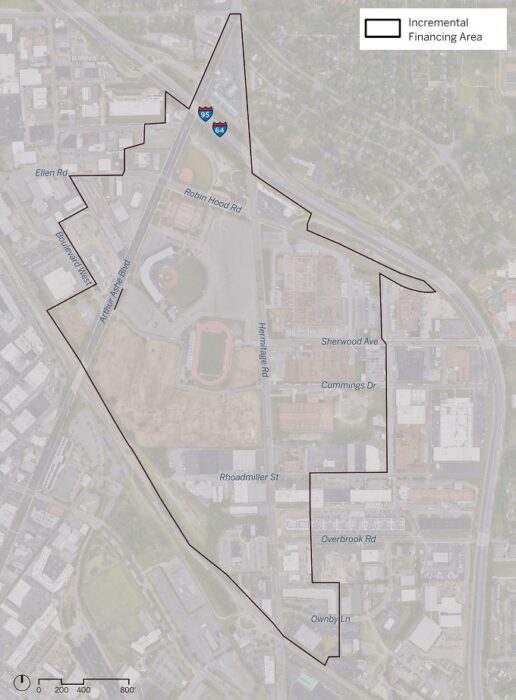
A map shows across-the-street properties around the Diamond District that would be added to the tax increment financing area.
Tax revenues from those properties would be used to pay nonrecourse bonds for the project that would be issued by a community development authority, or CDA. A form of tax increment financing, CDAs have been used on such projects as Short Pump Town Center in Henrico and are being used for Henrico’s GreenCity project.
Guillot said rising interest rates over the course of the negotiations made it challenging to nail down a final plan, and required adjustments, including to the tax increment financing area, which he said is aimed at improving areas around the Diamond District to make it more accessible and connected with surrounding neighborhoods.
“With the runup in rates, it threw us for a loop with our financing structure. We had to get really smart about, when you look at these bonds, how can you generate as many proceeds as possible based on what the district can support, and how do we stretch the budget as much as possible to buy the best quality ballpark we can afford while still having a responsible financial plan,” Guillot said.
Of the expanded financing area, Guillot said, “When we were doing some community meetings after the (project) award, people were saying, ‘This is great, we’re supportive of it; how do we get there safely and walk from our neighborhoods?’
“It became apparent that the Diamond District is bigger than itself. People want to be able to get there, and not necessarily in a car all the time, and there needs to be a funding source for it,” he said. “If we’re going to improve all this infrastructure and raise the game of this entire part of town, we need to make sure we’re connecting into all the surrounding neighborhoods.”
The expanded area includes the Quality Inn Central hotel across the interstate, which is planned to be replaced with a 375-unit apartment building. Such new development would generate various tax revenue to support the Diamond District. The larger CDA area also includes the planned VCU Athletics Village, which would not be taxable due to VCU’s ownership and would not contribute to the incremental financing.
Another change includes the city assuming responsibility for public infrastructure improvements in the project’s first phase. Those improvements would be funded using cash from the land sales, public utilities enterprise funds, general obligation bonds and other sources.
“By being able to do increment financing, we’ll be able to capture that revenue for the infrastructure improvements needed without having to rely on the city’s general debt capacity for those infrastructure improvements,” Saunders said.
The new stadium would fill about 7 acres of the 67-acre Diamond District site, in the district’s southwest corner at Arthur Ashe Boulevard and the railroad tracks. According to the agreements, RVA Diamond Partners would pay the city $16 million for the first-phase property that includes the stadium site, consisting of 22 acres at 2728 Hermitage Road and 2907 N. Arthur Ashe Blvd.
The land sale for the project’s first phase requires a seven-vote super-majority approval from City Council, while the development agreement requires a regular majority. Land for each phase would first be conveyed to the city’s Economic Development Authority, which would then sell the land to RVA Diamond Partners.
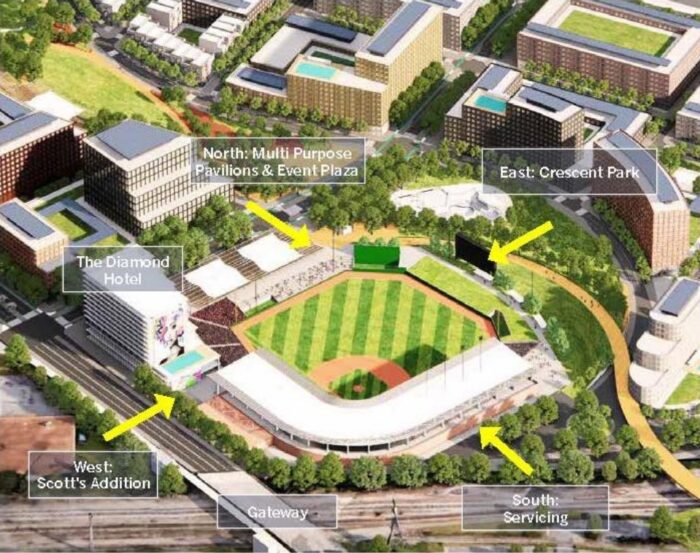
A rendering shows the new ballpark’s placement along with other components of the Diamond District’s first phase.
In addition to the new stadium, the Diamond District’s first phase would include 1,100 residential units, including lower-income units, 58,000 square feet of retail space, a 180-room hotel, structured and surface parking, a public park and related infrastructure upgrades.
Minimum investment in the first phase has been projected at over $627 million, contributing to a total project development cost for the entire Diamond District area of $2.4 billion. The larger development, to include a mix of office, residential, retail and hotel uses and infrastructure improvements, is projected for completion over a 15-year period.
The agreements introduced Monday were referred to the council’s Organizational Development Standing Committee, which meets next Monday, and could come back to council next month. Next steps include creation of the CDA, a timeframe for which has not been determined, and lease agreements with the Flying Squirrels and VCU, which also would use the new stadium.
Saunders said he is optimistic that council will support the agreements and give them a timely review to advance the project to its next phase.
“It’s been a lot of work. We’re talking about a $2.4 billion project that’s the largest economic development project in the city’s history,” he said. “We’ve been able to work collaboratively through some really strong economic headwinds…and we’ve been able to get to agreement in a way that protects the city but also allows us RVA Diamond Partners to respond to the changing market in a post-Covid world.”
The city was advised in the negotiations by John O’Neill and Brendan Staley with Hunton Andrews Kurth.

The final agreements come seven months after officials gathered at The Diamond to officially kick off the Diamond District project last fall. (BizSense file photo)
The City of Richmond has reached final terms with developer RVA Diamond Partners for their $2.4 billion Diamond District project – though not in time, officials said, for its centerpiece baseball stadium to be built before a 2025 deadline.
The definitive agreements were introduced at Monday’s City Council meeting, seven months after the parties entered into negotiations after reaching a preliminary agreement last fall. This new phase of the process sets the stage for final approvals that would tee up next steps, including completion of the ballpark’s design, creation of a Diamond District financing authority and the start of construction.
In an interview Monday, officials said the soonest that shovels could get in the ground would likely be early next year, leaving less time than the anticipated 18-month window that would be needed to complete the new stadium in time for the 2025 ball season – the deadline set by Major League Baseball.
While he acknowledged that the stadium would not be built in time to meet that deadline, Lincoln Saunders, the city’s chief administrative officer, said the parties are hopeful that, with the project underway, MLB will work with them to keep the Flying Squirrels ballclub in Richmond.
“It’ll be difficult if not impossible to meet the Opening Day 2025 deadline,” Saunders said, putting the stadium’s completion closer to spring 2026.
“We do believe that, when MLB sees the city’s commitment and the fact that we are looking to build a stadium with a high-quality fan experience, we can work with them on the timing for continuing in the existing Diamond and then transitioning to a beautiful new stadium by spring of ’26.”
Whether MLB would extend its deadline is not known. A request to MLB for comment Monday afternoon was not returned.
MLB, which in recent years took over management of Minor League Baseball, set the 2025 season as the deadline for all pro baseball facilities to meet new facility standards, which the 38-year-old Diamond does not. While upgrading The Diamond to meet those standards has been deemed unfeasible, MLB this year required $3.5 million in improvements ahead of the current season, which got underway this month.
Whether this revised timeline means the city will lose the Flying Squirrels – its minor-league ballclub of over a decade – remains to be seen.
Two weeks ago, in a statement to the Times-Dispatch, Flying Squirrels President Lou DiBella expressed concerns about the Diamond District’s progress and said “there will be no Opening Day 2026 in RVA” without the new stadium.
Acknowledging the situation, Saunders said Monday, “We know time is of the essence, and we want to be able to start building and break ground on a stadium for the Flying Squirrels as quickly as possible.”
DiBella and Todd “Parney” Parnell, the Flying Squirrels’ CEO, could not be reached for comment Monday night.
Saunders said the parties have been in constant communication with the ballclub.
Referring to DiBella’s statement, Saunders said, “I hope that seeing the progress we’ve made and the high level of thought that’s gone into crafting this agreement will address the concerns he rightfully raised about timing, and we need to get building.”
Incremental financing area expanded

The 67 acres are bordered by Arthur Ashe Boulevard, Hermitage Road, the interstate and the railroad tracks. (City documents)
The final agreements expand on minimum business terms and conditions that were agreed to by the parties and were approved by council last fall.
While the bulk of the overall project hasn’t changed, the new stadium is now projected to cost $90 million with a capacity of 9,000, compared to previous projections of $80 million and 10,000.
Jason Guillot, a principal with Thalhimer Realty Partners and the local lead for RVA Diamond Partners, said the major change that came out of the negotiations – and what primarily contributed to their duration – is in the project’s financing plan, which is now based on a larger tax increment financing area.
That area – tax revenue from which would be used to help finance the development over time – now includes adjoining properties beyond the 67 acres that make up the Diamond District site, including properties directly across Arthur Ashe Boulevard, Hermitage Road and Robin Hood Road.

A map shows across-the-street properties around the Diamond District that would be added to the tax increment financing area.
Tax revenues from those properties would be used to pay nonrecourse bonds for the project that would be issued by a community development authority, or CDA. A form of tax increment financing, CDAs have been used on such projects as Short Pump Town Center in Henrico and are being used for Henrico’s GreenCity project.
Guillot said rising interest rates over the course of the negotiations made it challenging to nail down a final plan, and required adjustments, including to the tax increment financing area, which he said is aimed at improving areas around the Diamond District to make it more accessible and connected with surrounding neighborhoods.
“With the runup in rates, it threw us for a loop with our financing structure. We had to get really smart about, when you look at these bonds, how can you generate as many proceeds as possible based on what the district can support, and how do we stretch the budget as much as possible to buy the best quality ballpark we can afford while still having a responsible financial plan,” Guillot said.
Of the expanded financing area, Guillot said, “When we were doing some community meetings after the (project) award, people were saying, ‘This is great, we’re supportive of it; how do we get there safely and walk from our neighborhoods?’
“It became apparent that the Diamond District is bigger than itself. People want to be able to get there, and not necessarily in a car all the time, and there needs to be a funding source for it,” he said. “If we’re going to improve all this infrastructure and raise the game of this entire part of town, we need to make sure we’re connecting into all the surrounding neighborhoods.”
The expanded area includes the Quality Inn Central hotel across the interstate, which is planned to be replaced with a 375-unit apartment building. Such new development would generate various tax revenue to support the Diamond District. The larger CDA area also includes the planned VCU Athletics Village, which would not be taxable due to VCU’s ownership and would not contribute to the incremental financing.
Another change includes the city assuming responsibility for public infrastructure improvements in the project’s first phase. Those improvements would be funded using cash from the land sales, public utilities enterprise funds, general obligation bonds and other sources.
“By being able to do increment financing, we’ll be able to capture that revenue for the infrastructure improvements needed without having to rely on the city’s general debt capacity for those infrastructure improvements,” Saunders said.
The new stadium would fill about 7 acres of the 67-acre Diamond District site, in the district’s southwest corner at Arthur Ashe Boulevard and the railroad tracks. According to the agreements, RVA Diamond Partners would pay the city $16 million for the first-phase property that includes the stadium site, consisting of 22 acres at 2728 Hermitage Road and 2907 N. Arthur Ashe Blvd.
The land sale for the project’s first phase requires a seven-vote super-majority approval from City Council, while the development agreement requires a regular majority. Land for each phase would first be conveyed to the city’s Economic Development Authority, which would then sell the land to RVA Diamond Partners.

A rendering shows the new ballpark’s placement along with other components of the Diamond District’s first phase.
In addition to the new stadium, the Diamond District’s first phase would include 1,100 residential units, including lower-income units, 58,000 square feet of retail space, a 180-room hotel, structured and surface parking, a public park and related infrastructure upgrades.
Minimum investment in the first phase has been projected at over $627 million, contributing to a total project development cost for the entire Diamond District area of $2.4 billion. The larger development, to include a mix of office, residential, retail and hotel uses and infrastructure improvements, is projected for completion over a 15-year period.
The agreements introduced Monday were referred to the council’s Organizational Development Standing Committee, which meets next Monday, and could come back to council next month. Next steps include creation of the CDA, a timeframe for which has not been determined, and lease agreements with the Flying Squirrels and VCU, which also would use the new stadium.
Saunders said he is optimistic that council will support the agreements and give them a timely review to advance the project to its next phase.
“It’s been a lot of work. We’re talking about a $2.4 billion project that’s the largest economic development project in the city’s history,” he said. “We’ve been able to work collaboratively through some really strong economic headwinds…and we’ve been able to get to agreement in a way that protects the city but also allows us RVA Diamond Partners to respond to the changing market in a post-Covid world.”
The city was advised in the negotiations by John O’Neill and Brendan Staley with Hunton Andrews Kurth.
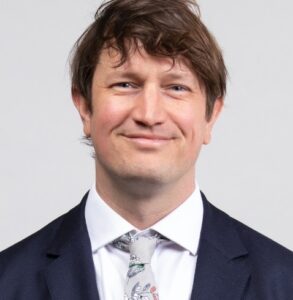
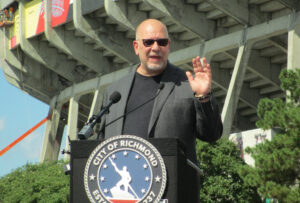
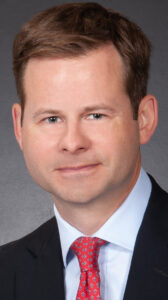
I think we need one more 6 figure study b/f pulling the trigger. This seems like a rash and knee jerk move. Chew on it City of RVA bureaucrats for another 10 yrs or so
Wait, do I detect sarcasm?
Not to mention that the choice of a local heavy group vs national heavyweights smells bad.
Lots of buildings, but no mention of increasing public transportation, increasing roads, increasing lanes of existing roads, adding a new 95 interchange? Where is the new stadium parking? Tell me again, why 2024 is going to be THE year this project gets started. I foresee phase 1 getting finished, and then the borrowing costs will stop the expansion. If my business was in the “expanded” tax zone – I would be nervous.
The roads are good enough as is around the ballpark. If anything, we need narrower lanes and bump outs at major crossing areas to encourage people to slow down in these areas. Also, would be nice to have buttons for people to press in order to activate flashing lights at the crossing. More then 2 straight lanes in each direction is too much and becomes a nightmare to cross for pedestrians. See Hull Street as a great example of what NOT to do with a road. Same with Route 10 now between 95 and 295.
The roads around the Diamond, and the I-95 interchange, now are poorly designed and backed up even on routine days. The seeming lack of parking in the new design, and the unwillingness or inability to rethink transportation (beyond an airy comment that people want to walk to the stadium), is remarkable. The project needs to happen. It’s just a shame they’re not dealing with the transportation infrastructure.
First there is the complaint about lack of parking and then there is the complaint about not rethinking transportation. Well, which is it? Should they continue to provide expansive parking to continue enabling the current transportation model or should they rethink the transportation model?
Clearly, because Richmond is hardly NYC or London, the answer is “continue enabling the current transportation model” — are we going to have Path Trains coming in from Hanover and Henrico?
The roads are far, far from “good enough”. There needs to be massive expansion, multiple dedicated turn lanes added, stop lights, etc just as a few examples. Can’t add 67 acres of high density development to existing grid, that would create immediate grid-lock. Not even debatable.
“Multiple dedicated turn lates” and “massive expansion” of roads? You do realize this is planned to be an urban area of a city, right? City residents want to live in an urban area and not short pump.
You do realize this is a planned “entertainment district” right? That means thousands visiting the area that do not live there. It isn’t a self-contained bubble.
The Diamond and existing roads already accommodates thousands of visitors—what’s your point? This area isn’t intended to be a driver’s paradise.
Obviously someone other than me has concerns about additional traffic because one of the graphics in the article shows the current vehicle count on the three Diamond District roads. Now add 50% more traffic count on a daily basis, and add an additional 3-4K vehicles (9K attendance) if the stadium actually fills up to capacity.
I can’t speak for Route 10, but I have never seen anyone walking along Hull Street…..
“I have never seen anyone walking along Hull Street”. Exactly! So why would we want a Hull Street like Boulevard?
I live along Hull St in the rapidly developing Moseley area and I can tell you the lack of walkability is absurd. We have teenagers crossing four lanes of traffic because no one had the foresight to put in crosswalks. No one can walk anywhere out here outside of their street. It’s stupid.
Considering there seems to be an article nearly weekly about a pedestrian being hit walking along Hull Street Road, it is clear that they do.
Think about this for a second.
Yes. I was a skeptic of putting a new ballpark in SB when they were still trying to make that happen— that area is ALREADY a bottleneck on I-95. I am ALL FOR lots more buildings and stuff in this proposed area, but yes, I think they need to consider the conduits a bit more and not just, as Joshua down there says, make airy comments about people walking. I don’t know how many Scott’s Addition hipsters (though there DOES seem to be an increasing amount of Yuppies — page Jello Biafra!) will be the supporters of local corporate baseball… Read more »
Oh, and where are they going to relocate the proliferation of homeless? The panhandlers have created a full on business near the Arthur Ashe center.
I bet you slay at cocktail parties!
Her failed presidential campaign speaks volumes.
Actually, the fake people at cocktail parties only bring up the homeless with fake concern these days.
Egad, you’re right! I guess we can’t ever try to improve the land then.
There is no logical reason for the replacement stadium for the Diamond to cost 90 million dollars. I would suggest to Jason Guillot that he reads my letter to the editor in last weeks Richmond Times Dispatch that refers to Oneok Field , in Tulsa Oklahoma that could be replicated for closer to 60 million dollars , and achieve the requirements of Major League Baseball. They simply don’t have to reinvent the wheel !
I could see an additional 30 mil needed for regulatory hurdles in RVA vs. Tulsa. DEQ alone is going to slow them down – which costs money.
And the one in Fredericksburg that was done privately costing $40 million. Far less than what is being proposed in RVA.
Fredericksburg’s park is a little jewel, but that’s where the similarity ends. Seats around 5,000, built behind a mega shopping center, backs up to a huge wooded (currently) area, none of the urban issues facing a complete Diamond rebuild. And a great place to see a game.
I really like the Fredericksburg stadium too and the way it was done privately. My feeling is that if the Squirrels and VCU want a bigger stadium than 5,000 seats – let them chip in and pay for it to be larger. Why should city taxpayers subsidize it with the TIF? Its discouraging to pay much higher real estate taxes, meals taxes, business licensing taxes, etc. than the surrounding counties so that sports teams (like VCU and the Squirrels) get a brand new stadium when it’s been proven it can be done privately like in Fredericksburg.
Won’t VCU be paying rent to use the stadium? If so aren’t they in fact “chipping in”?
Construction cost in 2010 were way down due to the economic downturn in 2008. We all know what inflation has done, If something wasn’t built and finished in the last 12 months the figures are not very comparable IMO. In my section of the construction industry the same project cost 40-50% more than just three years ago. On top of having parts that in some cases have increased 100% in cost, you still can’t get them in a timely matter after you agree to pay the increase.
Yes. I’ve heard the material that has not abated in cost is CONCRETE — that’s not great when you want to build a stadium.
WOW…just WOW! Promise after promise has been made only to be broken time and time again! When will the City get out of its own way and do the right thing. All of this should have been decided upon and put into place prior to this point.
To say this is disappointing is a grave understatement. Parney and the Squirrels have been one of the most positive things to happen in the City of Richmond in forever! I can’t even fathom losing them. The City and the Developers need to get off their tuffs and get this done!!
Richmond Taxpayers getting the squeeze once again.
More time, a smaller stadium, direct public tax dollars for infrastructure vs using CDA bond fund, a greater TIF district….wow this is going the right direction. Looking forward to it either failing to pass Council or the bonds failing to sell WITHOUT a moral obligation requirement. Is such a clause in the documents at this time?
Obviously, the article was not read. They are doing a CDA.
I did read it; especially the section where it says, the city will take responsibility for the infrastructure improvements, and will not use the CDA bond funds to do this work. They will use revenue from the sale of land, general revenue bonds,, utility bonds, and other fees.
The infrastructure, for this project will be paid for as if the city is building the infrastructure for a new neighborhood. The cost of the work will NOT be included in the CDA bond nor will it cost be paid back by the developer or TIF revenue from the district.
I am sure they are conferring with Squirrels management on size but I hate to see them cut stadium capacity. When the Diamond (12,000 Cap) was built in 1985 the Richmond Metro population was about 500,000 less than now and we are adding 10,000 people per year. Keep in mind we better be thinking a 40 year stadium at minimum the way Richmond moves on new projects. Not hard to think that the Richmond Metro population could be pushing 2M by the time this stadium is obsolete. The Squirrels have done a FANTASTIC job getting people to come to the… Read more »
The lack of the Squirrels organization being included in the announcement of the deal and the lack of a statement since the yesterday reads volumes into their “cooperation” with the city.
Per RTD, average game attendance in the 2022 season was 6,160, which led all 30 AA teams. With all the corporate signage covering the top section of bleachers at the Diamond, total (actual) capacity today is less than 12,000.
Everyone received a deadline, RVA is not special enough to tell the MLB, no MLB wait 1 more year I have other things I need to fix first. Really??? First the Coliseum downtown is to go instead of renovation and now possibly the Diamond Minor Leagues may be taken away from the City. Richmond is so behind and removed from being a modern city
A deadline from the MLB? Hahaha, tell them to pound sand. The MLB should not be dictating the development of our city when they don’t put up their own money to make money from a game.
no, they’ll just require the team to be moved and prohibit an affiliated team from relocating here. Tough guy posturing always works….
Is that sense I smell?
The fact that some other locality would no doubt like the Squirrels or any other minor league team does not make them correct.
Richmond should plan on a new team to go with that new statium,If I were MLB I wouldn’t believe a word a they say.The roads are fine now.
MLB Should tell the city sorry, you had plenty of time.
History shows what a debacle the City of Richmond’s “leadership” has been for decades.
Yes to the last part.
But really, it is only dumb cities that care what sports franchises think.
Go to Charleston and copy the Riverdogs Stadium, it’s beautiful and perfect. The palm trees are optional but would be appreciated.